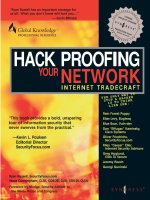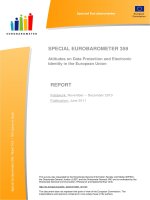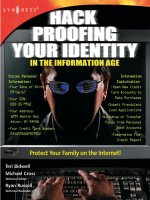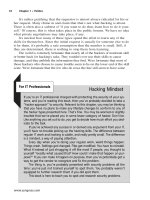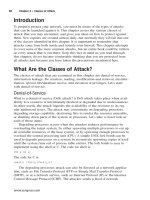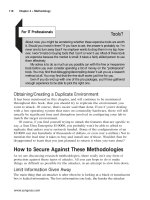hack proofing your identity in the information age - protect your family on the internet!
Bạn đang xem bản rút gọn của tài liệu. Xem và tải ngay bản đầy đủ của tài liệu tại đây (8.9 MB, 393 trang )
221_HPID_FM.qxd
6/7/02
5:41 PM
Page i
With more than 1,500,000 copies of our MCSE, MCSD, CompTIA, and Cisco
study guides in print, we continue to look for ways we can better serve the
information needs of our readers. One way we do that is by listening.
Readers like yourself have been telling us they want an Internet-based service that would extend and enhance the value of our books. Based on
reader feedback and our own strategic plan, we have created a Web site
that we hope will exceed your expectations.
is an interactive treasure trove of useful information focusing on our book topics and related technologies. The site
offers the following features:
■
One-year warranty against content obsolescence due to vendor
product upgrades. You can access online updates for any affected
chapters.
■
“Ask the Author” customer query forms that enable you to post
questions to our authors and editors.
■
Exclusive monthly mailings in which our experts provide answers to
reader queries and clear explanations of complex material.
■
Regularly updated links to sites specially selected by our editors for
readers desiring additional reliable information on key topics.
Best of all, the book you’re now holding is your key to this amazing site.
Just go to www.syngress.com/solutions, and keep this book handy when
you register to verify your purchase.
Thank you for giving us the opportunity to serve your needs. And be sure
to let us know if there’s anything else we can do to help you get the
maximum value from your investment. We’re listening.
www.syngress.com/solutions
221_HPID_FM.qxd
6/7/02
5:41 PM
Page ii
221_HPID_FM.qxd
6/7/02
5:41 PM
Page iii
HACK
PROOFING
YOURINFORMATION AGE
IDENTITY
IN THE
Protect Your Family on the Internet!
Teri Bidwell
Michael Cross
Ryan Russell
Technical Editor
Technical Reviewer
221_HPID_FM.qxd
6/7/02
5:41 PM
Page iv
Syngress Publishing, Inc., the author(s), and any person or firm involved in the writing, editing, or
production (collectively “Makers”) of this book (“the Work”) do not guarantee or warrant the results
to be obtained from the Work.
There is no guarantee of any kind, expressed or implied, regarding the Work or its contents.The Work
is sold AS IS and WITHOUT WARRANTY. You may have other legal rights, which vary from state
to state.
In no event will Makers be liable to you for damages, including any loss of profits, lost savings, or
other incidental or consequential damages arising out from the Work or its contents. Because some
states do not allow the exclusion or limitation of liability for consequential or incidental damages, the
above limitation may not apply to you.
You should always use reasonable care, including backup and other appropriate precautions, when
working with computers, networks, data, and files.
Syngress Media®, Syngress®,“Career Advancement Through Skill Enhancement®,” and “Ask the
Author UPDATE®,” are registered trademarks of Syngress Publishing, Inc. “Mission Critical™,”“Hack
Proofing®,” and “The Only Way to Stop a Hacker is to Think Like One™” are trademarks of Syngress
Publishing, Inc. Brands and product names mentioned in this book are trademarks or service marks of
their respective companies.
KEY
001
002
003
004
005
006
007
008
009
010
SERIAL NUMBER
GT6YUJ8KFC
2PBP9MJ5MR
83N5M44ER4
VZW233N54N
NFG4R77TG4
NV88HTR46T
XC5CMU6NVH
KTCD54MPE4
SGD34Y5GFN
T945AQ2YT5
PUBLISHED BY
Syngress Publishing, Inc.
800 Hingham Street
Rockland, MA 02370
Hack Proofing Your Identity in the Information Age
Copyright © 2002 by Syngress Publishing, Inc. All rights reserved. Printed in the United States of
America. Except as permitted under the Copyright Act of 1976, no part of this publication may be
reproduced or distributed in any form or by any means, or stored in a database or retrieval system,
without the prior written permission of the publisher, with the exception that the program listings
may be entered, stored, and executed in a computer system, but they may not be reproduced for
publication.
Printed in the United States of America
1 2 3 4 5 6 7 8 9 0
ISBN: 1-931836-51-5
Technical Editor: Michael Cross
Cover Designer: Michael Kavish
Technical Reviewer: Ryan Russell
Page Layout and Art by: Shannon Tozier
Acquisitions Editor: Catherine B. Nolan
Copy Editor: Mary Millhollon
Developmental Editor: Kate Glennon
Indexer: Claire Splan
Distributed by Publishers Group West in the United States and Jaguar Book Group in Canada.
221_HPID_FM.qxd
6/7/02
5:41 PM
Page v
Acknowledgments
We would like to acknowledge the following people for their kindness and support
in making this book possible.
Ralph Troupe, Rhonda St. John, Emlyn Rhodes, and the team at Callisma for their
invaluable insight into the challenges of designing, deploying and supporting worldclass enterprise networks.
Karen Cross, Lance Tilford, Meaghan Cunningham, Kim Wylie, Harry Kirchner,
Kevin Votel, Kent Anderson, Frida Yara, Jon Mayes, John Mesjak, Peg O’Donnell,
Sandra Patterson, Betty Redmond, Roy Remer, Ron Shapiro, Patricia Kelly, Andrea
Tetrick, Jennifer Pascal, Doug Reil, David Dahl, Janis Carpenter, and Susan Fryer of
Publishers Group West for sharing their incredible marketing experience and
expertise.
Jacquie Shanahan, AnnHelen Lindeholm, David Burton, Febea Marinetti, and Rosie
Moss of Elsevier Science for making certain that our vision remains worldwide in
scope.
Annabel Dent and Paul Barry of Elsevier Science/Harcourt Australia for all their help.
David Buckland,Wendi Wong, Marie Chieng, Lucy Chong, Leslie Lim, Audrey Gan,
and Joseph Chan of Transquest Publishers for the enthusiasm with which they receive
our books. And welcome back to Daniel Loh—glad to have you back Daniel!
Kwon Sung June at Acorn Publishing for his support.
Ethan Atkin at Cranbury International for his help in expanding the Syngress
program.
Jackie Gross, Gayle Voycey, Alexia Penny, Anik Robitaille, Craig Siddall, Darlene
Morrow, Iolanda Miller, Jane Mackay, and Marie Skelly at Jackie Gross & Associates
for all their help and enthusiasm representing our product in Canada.
Lois Fraser, Connie McMenemy, Shannon Russell, and the rest of the great folks at
Jaguar Book Group for their help with distribution of Syngress books in Canada.
v
221_HPID_FM.qxd
6/7/02
5:41 PM
Page vii
Author
Teri Bidwell (GCIA) is an independent security consultant, a GIAC
Certified Intrusion Analyst, and a member of The SANS Institute GGIA
Advisory Board. Additionally,Teri has over 10 years experience designing
and building secure computer infrastructures for companies of all sizes.
She has taught multiple courses and written articles on various topics
related to computer security and analysis of computer intrusions.Teri is
also a contributing author to the Syngress publication Hack Proofing Your
E-Commerce Site (ISBN: 1-928994-27-X). As an independent security
consultant,Teri assists companies and individuals evaluate and reduce their
risk for computer network intrusion; her specialties include creating security policies, establishing secure administrative procedures, and installing
both firewalls and intrusion detection systems.
Technical Editor and Contributor
Michael Cross (MCSE, MCP+I, CNA, Network+) is an Internet
Specialist and Programmer with the Niagara Regional Police Service and
has also served as their Network Administrator. Michael performs computer
forensic examinations of computers involved in criminal investigations, and
has consulted and assisted in cases dealing with computer-related/Internet
crimes. He is responsible for designing and maintaining their Web site at
www.nrps.com, and two versions of their Intranet (one used by workstations, and another accessed through patrol vehicles). He programs applications used by various units of the police service, has been responsible for
network security and administration, and continues to assist in this regard.
Michael is part of an Information Technology team that provides support to
a user base of over 800 civilian and uniform users. His theory is that when
vii
221_HPID_FM.qxd
6/7/02
5:41 PM
Page viii
the users carry guns, you tend to be more motivated in solving their
problems.
Prior to working for the Niagara Regional Police Service, Michael
worked as an instructor for private colleges and technical schools in
London, Ontario, Canada. It was during this period that he was recruited
as a writer for Syngress Publishing, and became a regular member of their
writing team. Michael also owns KnightWare, a company that provides
Web page design and other services. He resides in St. Catharines, Ontario
Canada, with his lovely wife, Jennifer.
Technical Reviewer
Ryan Russell is the best-selling author of Hack Proofing Your Network:
Internet Tradecraft (Syngress Publishing, ISBN: 1-928994-15-6), and
Hack Proofing Your Network, Second Edition (Syngress Publishing,
ISBN: 1-928994-70-9). He is an Incident Analyst at SecurityFocus, has
served as an expert witness on security topics, and has done internal security investigation for a major software vendors. Ryan has been working in
the IT field for over 13 years, the last seven of which have been spent primarily in information security. He has been an active participant in various security mailing lists, such as BugTraq, for years, and is frequently
sought after as a speaker at security conferences. Ryan has contributed to
four other Syngress Publishing titles on the topic of networking, and four
on the topic of security. He holds a Bachelor’s of Science degree in
Computer Science.
viii
221_HPID_TOC.qxd
6/10/02
11:40 AM
Page ix
Contents
Foreword
Online Theft
Tthink of your computer’s
hard drive as an online
“wallet” that can contain
the following:
■
Computer login
accounts
■
Screen names
■
Electronic commerce
account numbers
■
E-mail addresses
■
Computer and domain
names
■
Computer IP addresses
■
Passwords, passwords,
and more passwords
Chapter 1 Identity Theft: Are You At Risk?
Introduction
Defining Identity Theft
Take a Risk Factor Test
Why Do They Do It?
How Do They Get Away with It?
Dumpster Diving
Shoulder Surfing
Social Engineering
Physical Theft
Online Theft
Privacy Erosion
Limited Enforcement Resources
Recognizing Identity Theft When It Happens
Unauthorized Credit Cards
Unauthorized Phone or Other
Utility Services
Bank Fraud
Fraudulent Loans
Government Documents
Other Forms of Identity Theft
Understanding What Electronic Information
Is Private
Striving for Theft Prevention
Keeping Private Information Private
Protecting Your Social Security Number
xix
1
2
3
4
5
6
7
8
8
10
12
14
15
15
16
16
17
18
18
18
19
22
26
26
ix
221_HPID_TOC.qxd
x
6/10/02
11:40 AM
Page x
Contents
Viewing Hidden
Programs
Hidden programs are programs that run on your
system without your being
aware of them. Some of
these programs are called
spyware, which is software that secretly gathers
personal and organizational information from
your computer, monitors
your Internet activity,
and/or obtains other information about you. You
can see if hidden programs are running on
your system using Task
Manager on systems
running Windows
XP/NT/2000.
Taking Advantage of Marketing Opt-Out
Programs
Using Search Engine Opt-Out Services
Using the Direct Marketing Association’s
Opt-Out Service
Protecting Your Computer
Applications
Web Browsing
Network
Your Family’s Online Activities
Summary
Solutions Fast Track
Frequently Asked Questions
Chapter 2 Protecting Your Hard Drive
Introduction
Know Your Computer
Temporary Files
Temporary Internet Files
Deleting Files Permanently for Privacy
Other Information that Might be on Your
Computer
What Are You Protecting?
Password Protecting Your Computer
Programs and Files
Antivirus Software:Your First Line of Defense
What You Might Not Know about Antivirus
Software
Why Update?
What Kinds of Software Are Available?
Manually Updated Signatures
Automatically Updated Signatures
Web-based Software
Performing Signature Updates
McAfee
Norton
29
30
32
34
34
34
34
35
36
37
38
41
43
44
44
46
48
49
52
54
55
57
59
60
61
61
62
62
63
63
63
64
221_HPID_TOC.qxd
6/10/02
11:40 AM
Page xi
Contents
F-Prot
Is Your Antivirus Software Working?
Updating Your Software
The Number One Mistake People Make
Functionality Vs. Secure Updates
Installing Security Patches
Internet Explorer
Outlook
IIS
Netscape
Opera
Beware of the Free Stuff
Avoiding Account Sharing
Common Reasons, Risks, and Deterrents
for Sharing Accounts
Creating Multiple Accounts in Windows
Setting Up an Account in Windows XP
Setting Up an Account in Windows 2000
Creating Multiple Internet Connection
Accounts
Setting up Multiple Internet
Connection Accounts in Windows 98
Setting up Multiple Internet
Connection Accounts in Windows XP
Setting up Multiple Internet
Connection Accounts in Windows 2000
Creating Multiple E-mail Accounts
with Outlook Express
Using Disk and File Encryption
Choosing Strong Passwords
Avoiding Weak Passwords
Protecting PINs
Tradeoffs: Using Password Storage
Creating Strong Passwords You Can
Remember
xi
65
66
68
69
70
70
71
72
72
73
73
73
74
75
76
77
78
78
79
79
81
82
83
86
87
89
90
93
221_HPID_TOC.qxd
xii
6/10/02
11:40 AM
Page xii
Contents
Summary
Solutions Fast Track
Frequently Asked Questions
E-mail Privacy Is Not
Just About SPAM
Check privacy policies of
Web sites to determine
what they do with any
information they acquire
from you.
If you receive SPAM, check
the message to see if they
provide a method to be
removed from their
mailing list. Look into
software or services
provided by your Internet
Service Provider to have email flagged and/or
deleted before reaching
your inbox.
Disable cookies to prevent
information from being
sent to Web sites.
Chapter 3 Keeping Your E-mail Private
Introduction
E-mail Privacy Is Not Just about Spam
How E-mail Services Work
Big Brother and Your E-mail
How E-mails Can Get Lost
Understanding Spam
E-mail Attacks Are Not Just about Viruses
E-mail Attachments
How Your E-mail Can Be Hijacked
E-mail Interceptions
Recognizing Mail Scams
Solicitations and Chain Letters
Nigeria 419 Scam
Spam as Social Engineering
Using Antivirus Protection for E-mail
Hiding Your E-mail Identity
Knowing What’s in Your E-mail Headers
Knowing What Your Chat Says about You
Setting Up Anonymous E-mail
Free Anonymous E-mail
E-mail Encryption Made Simple
Using Pretty Good Privacy (PGP) with
Microsoft Outlook
Using Personal Certificates with Netscape
Verifying E-mail Senders in Outlook
Importing a Personal Certificate File into
Opera
Choosing a Secure E-mail Provider
Using Encrypted Web-based E-mail
Summary
Solutions Fast Track
Frequently Asked Questions
98
99
101
103
104
104
105
108
110
113
114
115
116
116
119
120
122
124
126
128
128
132
133
134
135
138
140
141
143
144
144
146
146
149
221_HPID_TOC.qxd
6/10/02
11:40 AM
Page xiii
Contents
xiii
Chapter 4 Self Defense on the Web
151
Introduction
152
Understanding Risk on the Web
152
Learning to Be Street Smart on the Web
154
Understanding the Privacy Policy
155
Managing Risk on the Web
159
Protecting Yourself With SSL Certificates 159
Avoiding Malicious Applets
162
Managing Passwords
164
Using Microsoft’s Passport
165
Protecting Your Purchasing Power
166
PayPal and CyberCash
166
American Express Private Payments
167
Microsoft Wallet
167
Anonymous Web Surfing
168
Improving Browser Safety
169
Updating Your Browser Software
169
Internet Explorer
170
Netscape
170
Opera
170
Putting Browser Security Features to Work
171
Internet Explorer
171
Netscape
171
Opera
171
Covering Your Internet Footprints
171
Deleting Hidden Information About You
172
Opting Out of Ad-ware Cookies
176
Abacus: A Division of DoubleClick
177
ValueClick
178
Advertising.com
179
Summary
181
Solutions Fast Track
182
Frequently Asked Questions
185
221_HPID_TOC.qxd
xiv
6/10/02
11:40 AM
Page xiv
Contents
Employer-Provided
Internet Access
According to the FBI, the
vast majority of corporate
information theft occurs
by employees taking
advantage of access to
information they probably
shouldn’t have.
Companies have every
right to protect their own
informational assets by
monitoring how those
assets are being used.
Chapter 5 Connecting to the
Internet Safely
187
Introduction
188
Different Connections, Different Risks
189
Understanding Network Terminology
189
Dial-up Connections
190
America Online
192
Employer-Provided Internet Access
194
Always-on Broadband
196
DSL, ISDN, and Cable Modem
197
Cable Modem
198
ISDN Modem
199
Wireless
199
Understanding Data Interception
200
Snooping on a Network with a Sniffer
201
Snooping on Your Network with
Network Neighborhood/My Network
Places
203
Snooping on Your Network with nbtstat 204
Taking Precautions
207
Setting Permissions for Shared Drives
and Files
208
Registering Your Domain.com
211
Turning Off Unneeded Services
212
Securing Your Personal Web Server
215
Firewalls for the Home
216
Personal Firewalls for Home Office Use
219
Network Firewalls for Home Office Use
221
Using Common Firewall Configuration
Features
223
Network Configuration
223
Setting Inbound Filtering
226
Setting Outbound Filtering
227
Virtual Private Networks
228
Connection Alerts
229
221_HPID_TOC.qxd
6/10/02
11:40 AM
Page xv
Contents
SafeKids Kid’s Pledge
1. I will not give out
personal information,
such as my address,
telephone number,
parents’ work
address/telephone
number, or the name
and location of my
school without my
parents’ permission.
2. I will tell my parents
right away if I come
across any information
that makes me feel
uncomfortable.
3. I will never agree to
get together with
someone I “meet”
online without first
checking with my
parents.
4. I will never send a
person my picture or
anything else without
first checking with my
parents.
5. I will not respond to
any messages that are
mean or in any way
make me feel
uncomfortable.
6. I will talk with my
parents so that we can
set up rules for going
online.
7. I will not give out my
Internet password to
anyone (even my best
friends) other than my
parents.
8. I will be a good online
citizen and not do
anything that hurts
other people or is
against the law.
Summary
Solutions Fast Track
Frequently Asked Questions
Chapter 6 Are Your Kids Putting
You at Risk?
Introduction
Raising Children in the Digital Age
Keeping Clear Online Identities within
Families
Supervising Online Activities
Channeling a Child’s Interest in Hacking
Identifying Risky Software and Risky Behavior
Chat Programs
Web Forums and Newsgroups
Massive Multiplayer Online Games
File-Sharing Software
Hacking Tools
Monitoring Online Activities
Parental Contracts
Application Logging
Browser Activity Logging
Keystroke Logging
Screen Imaging
Avoiding Monitoring Pitfalls
Summary
Solutions Fast Track
Frequently Asked Questions
Chapter 7 If You Become a Victim
Introduction
Taking Immediate Action
Step 1: Filing Police Reports
Step 2: Reporting Fraud and Stolen Accounts
Closing Credit Card Accounts
Closing Bank and Loan Accounts
Reporting and Closing Other
Commercial Accounts
xv
231
234
236
239
240
241
244
246
247
250
250
252
253
254
256
257
258
260
261
264
264
265
267
268
270
271
272
272
273
276
276
277
279
221_HPID_TOC.qxd
xvi
6/10/02
11:40 AM
Page xvi
Contents
Answers to Your
Frequently Asked
Questions
Q: I keep getting these
embarrassing pop-up
ads on my computer
for things like viagra
and pornographic
sites, but I’ve never
visited anything like
that on the Web! Does
this mean someone
else is using my
computer?
A: No. What it means is
that you’ve visited
some fairly innocuous
Web site that has set a
cookie or installed
some spyware on your
computer that is
displaying those ads. If
that’s the case, you
should follow the
instructions in Chapter
4 for deleting cookies
and temporary files
from your computer,
and blocking ad-ware.
You might have
installed some
software that contains
spyware within it. It’s
easy to do if you
download software
from the Internet
frequently. If this is the
case, the pop-up ads
won’t go away until
you remove the
spyware from your
computer.
Dealing with Compromised Online
Accounts
Step 3: Notifying the Federal Trade
Commission (FTC)
Managing Other Fraud Situations
Reporting Stolen IDs
Dealing with Telephone Fraud
Dealing with Stolen Wireless Service
Managing the Fallout
Contacting Credit Bureau Services
Obtaining a Report
Understanding Your Credit Report:
A Case Study
Preparing Your Victim’s Statement
Knowing When to Seek Legal Help
Keeping Records
Locating Government Resources
Statutes in Your State
Federal Trade Commission
Understanding the Fair Credit
Reporting Act
Other Suggested Resources
Privacy Rights Advocates
The Electronic Frontier Foundation
The Privacy Rights Clearinghouse
The Identity Theft Resource Center
Privacy International
The Electronic Privacy Information
Center
The Privacy Coalition
The Global Internet Liberty Campaign
Summary
Solutions Fast Track
Frequently Asked Questions
280
281
282
282
283
284
284
285
286
288
290
292
292
292
293
293
294
294
295
296
296
296
296
296
297
297
298
299
301
221_HPID_TOC.qxd
6/10/02
11:40 AM
Page xvii
Contents
NOTE
Most browsers have an
option that allows you
to enter your personal
information profile. A
form typically asks for
the kind of information
you’d put on a business
card. The browser can
then insert the information into Web forms, emails, or news postings
without having to
retype it. This feature
makes life easier, certainly, but it also stores
private information you
might not want to be
viewable by everyone.
There is a small risk
that the information
might be shared with
the wrong service, your
computer could be
stolen, or the information could otherwise be
obtained without your
knowledge.
Chapter 8 Configuring Your
Browser and Firewall
Introduction
Managing Your Web Browser’s Security Features
Internet Explorer Version 6
Netscape 6.2
Opera 6
Configuring Your Home Firewall
BlackICE Defender for Windows
Packet Log Menu
Evidence Log Menu
Back Trace Menu
Intrusion Detection Menu
Notifications Menu
Prompts Menu
Zone Alarm Pro for Windows
Firewall Menu
Program Control Menu
Alerts and Logs Menu
Privacy Menu
Email Protection Menu
Siemens Speedstream SS2602 DSL/Cable
Router
Pros and Cons of Using the Siemens
Router
Configuring the Router on the Network
Configuring Advanced Settings
Applications Port List
Index
xvii
305
306
306
307
313
316
319
319
323
323
323
324
326
326
328
329
331
335
336
337
337
339
339
342
346
357
221_HKPID_fore.qxd
6/10/02
11:28 AM
Page xix
Foreword
Even though I’ve spent several years studying how criminals break into computer
systems, I thought I was just being paranoid the first time I saw one of those signature capture devices at the local electronics store.You know the kind I’m talking
about, where the clerk slides the receipt from your credit card onto a flat pad, and
you sign your name onto it using a pen that writes on the slip in ink but also records
an imprint of your signature electronically. Needless to say my curiosity got the
better of me. I asked the clerk, “What happens to my signature after I sign the slip?” I
figured that my signature was sent to the financial network that approved the charge
on my credit card, in order for it to be compared against my original credit application, similar to the way banks use the signature cards they keep on file.
The clerk replied, “All of the signatures are stored on the store’s server, in the
backroom.We (the store) hold on to all of the electronic signatures just in case the
credit card company ever needs to verify that you signed a receipt.”This was definitely not the response I expected.
I then asked the clerk “Well, is the server in the back room locked up?” Again, I
received an unexpected answer.
“No, it’s in the office out back that the executive staff for the store use.”
“Is access to the computer restricted?” I continued.
“Well, there’s only one person who knows how to work on that system, so
nobody else usually touches it,” he replied.
xix
221_HKPID_fore.qxd
xx
6/10/02
11:28 AM
Page xx
Foreword
“Is the data on the computer ever backed up?”
“You know, that’s a really good question.” Again, not the answer I was looking for.
Truthfully, I’d have been happier to be told that my signature was sent to a big
credit card company. At least they’d have a dedicated computer security staff to protect all of that data. But here was this man telling me that my private information
was easily accessible to various people.
After digging into the technology behind the devices used by the store, I learned
that my signature was encrypted before being sent to the computer in the back
room; thereby significantly reducing it’s value to any thief.Thank goodness. However,
the entire incident made me wonder: How much technology out there is making
mistakes with people’s private information by storing it insecurely, using weak
encryption, and ultimately putting it into the hands of untrained operators for whom
security is not the primary focus?
If you’re like most people, your day includes writing checks or using a debit card
at stores, using credit cards at the gas station, or using an ATM terminal to get cash. If
you’re among the growing numbers of Internet users, you’ve probably also bought a
thing or two online, and might even do your banking or trade stocks online as well.
Each time you enter into any of these transactions, you must share private information about yourself with the outside world. Most people don’t give it a second
thought. But do you know how your private information will be used? Is your private information safe from theft?
You may not care about the answers to these questions until you find out one
day that someone else has stolen this private information and used your identification
to commit your name to a legally binding agreement such as a credit card charge, a
loan application, a driver’s license, or a variety of other agreements.What do you do?
How do you repair the damage? How can you prevent it from happening again?
Hack Proofing Your Identity is designed to answer these questions, and teach you the
methodology of how to find answers to questions this book will inevitably be unable
to address. Unfortunately, it is impossible to anticipate all the possible ways in which
someone might steal your identity given the current rapid evolution rate of new
technology. Instead, we hope this book will teach you how to think about your personal information in a new way; how to recognize when you are unnecessarily
putting yourself or your family at risk for identity theft, and how to recognize
opportunities to reduce that risk by making small changes in the way you manage
your personal privacy, both online and offline.
www.syngress.com
221_HKPID_fore.qxd
6/10/02
11:28 AM
Page xxi
Foreword
xxi
Like other books in the Syngress “Hack Proofing” series, this book includes more
than just a bullet list of things you should do—it also provides explanations and
shows you examples that illustrate the reasons why you should do them.
Chapter 1, What is Identity Theft?, starts us off with a definition of identity
theft, what it is, how it happens, and shows how identity theft is more prevalent
than you think.
Chapter 2, Protecting Your Hard Drive, guides us through the various steps of
protecting our hard drives through the use of strong passwords, updated anti-virus
software, and proper handling of temporary files.There’s a lot more hiding on your
hard drive than you may be aware of, and identity thieves are everywhere and know
what to look for.
Chapter 3, Keeping Your E-mail Private, shows us how e-mail opens up your computer to the outside world. Discussions of viruses, malicious code, SPAM, and e-mail
fraud are included, as well as tips for protecting your personal information and preventing any potential computer damaging security breaches.
Chapters 4 and 5, Self Defense on the Web and Connecting to the Internet Safely, will
look at what a network is, how your network and the Internet can be used in identity theft, and how to avoid common mistakes that make it easy for a thief to do his
work. As you examine the risks of various types of network and Internet connections, we will demonstrate a few surprisingly simple ways to access other computers.
These demonstrations are intended only for educational purposes—to show you the
kinds of information other computers on your network can see.
Chapter 6 takes on the sensitive topic of Are Your Kids Putting You At Risk?
Unfortunately, children can be at risk on the Internet if they are not properly educated about the dangers of sharing personal information (both their own and that of
their parents). On the flipside, children could be breaking the law without even
knowing it, depending on their interests or proficiency with computers, by downloading copyrighted material, accessing the Internet with a connection provided by
their parent’s employer, and so on. This chapter stresses the importance of proper
education, and offers some suggestions for monitoring your child’s activities online.
Chapter 7 offers suggestions and possible answers to the question, What to Do If
You Become A Victim? This chapter offers helpful tips on contacting law enforcement,
filing reports, contacting credit bureaus, and rebuilding your finances after becoming
a victim of identity theft.
www.syngress.com
221_HKPID_fore.qxd
xxii
6/10/02
11:28 AM
Page xxii
Foreword
Finally, Chapter 8, Configuring Your Browser and Firewall, offers some practical stepby-step instructions for setting up your Internet browser and personal firewalls to
further protect your computer from intruders or identity thieves
Unlike other books in the Syngress series, this book is not directed exclusively at
a high-tech audience.We assume you have at least one computer in your home that’s
connected to the Internet, perhaps another one at work, and regularly use e-mail and
surf the Web. If you are an IT professional, you may already know most of the technical information in this book; however, you might not have applied this knowledge
to the protection of your own private information.This book will help technical and
non-technical people alike understand how to better protect private, personal information and avoid becoming a victim of identity theft.
—Teri Bidwell, GCIA
www.syngress.com
221_HPID_01.qxd
6/6/02
1:30 PM
Page 1
Chapter 1
Identity Theft:
Are You At Risk?
Solutions in this chapter:
■
Defining Identity Theft
■
Understanding What Electronic
Information Is Private
■
Striving for Theft Prevention
■
Keeping Private Information Private
! Summary
! Solutions Fast Track
! Frequently Asked Questions
1
221_HPID_01.qxd
2
6/6/02
1:30 PM
Page 2
Chapter 1 • Identity Theft: Are You At Risk?
Introduction
The use of a seal, card, or other identification while making a purchase or signing
a contract is a custom almost as old as history. As merchants and their customers
have begun using the Internet in recent years to conduct business online, they
have been challenged to find digital forms of identification that mimic traditional, trusted forms, such as hand-written signatures and photo IDs. Because traditional forms of identification don’t work well on the Internet, no universal
form of ID has been found to be suitable for companies wanting to conduct
business online.
Web site owners, merchants using computers to track purchases, and electronic service providers have each been forced to reach their own, unique solutions for identifying customers using only computers. Many merchants using
electronic commerce rely on passwords. Some have embraced electronic identification known as digital certificates. Most attach an account name or number, e-mail
address, physical address, telephone number, and other identifying information to
their customers as well.
Each company with whom you do business electronically increases the number
of identifiers associated with you.These digital forms of identification (like passwords) require safeguarding just like any traditional form (like a license). However,
because they are not tangible (you can’t see or touch them), your traditional
notions of how to lock up your belongings do not apply. Not only does that put
you at risk, but, just as thieves often prey upon people struggling to understand
what’s happening around them, cyber criminals can more easily take advantage of
people for whom locking up their digital information is a new concept.
Today, you are asked to sign credit charge slips using signature-capturing
devices designed to copy your signature for storing electronically.You can type
your credit card numbers into a Web form and a product will magically appear at
your door several days later. An unprecedented number of homes are exposing
private information, stored on their computers, to the Internet 7 days a week, 24
hours a day.These are all completely new challenges to our traditional notions of
personal identification, and these challenges bring with them new responsibilities
for protecting personal information.
Businesses and consumers are beginning to look at personal identification in a
way never before required. No longer is it sufficient to keep your wallet on your
bed stand where it’s safe each night.You need to understand how to protect your
identity in its digital form as well.
www.syngress.com
221_HPID_01.qxd
6/6/02
1:30 PM
Page 3
Identity Theft: Are You At Risk? • Chapter 1
In this chapter, we investigate the forms of identification that make up your
identity in an Internet-enabled world.We begin by focusing on physically
securing the sources of information that identify you as an individual, using tangible security methods.We finish the chapter by introducing some of the ways
you can protect your personal information using the less tangible features of your
computers and the Internet.Those methods are covered in depth in this book’s
remaining chapters.
Defining Identity Theft
Identity theft is a crime involving someone impersonating a victim for the purpose
of financial gain or other personal gain.The victim could be an individual or a
business, and the perpetrator could be one person or several individuals acting as
part of a theft or fraud ring. Often, the theft of a person’s or business’s identity is
used to commit other crimes as well, such as credit card fraud, submitting loan
applications in another person’s name, and so on.
Impersonating someone for personal gain has been a problem for centuries,
but it has become more prevalent as easily accessible information about people
has become more prevalent.Whereas common targets for identity theft used to
be the very rich or famous, today ordinary citizens are much more likely to be
victims. Here are a few statistics that have been accumulated in recent years by
various U.S. government agencies:
■
Identity theft is a crime that happens to ordinary people, just like you
and me; the average age of victims is 41.
■
The U.S. Secret Service estimated the cost of identity theft at $745 million in 1997. Since that time, identity theft has become more prevalent,
with total costs estimated in the billions to victims, financial institutions,
and taxpayers.
■
The number of new cases of identity theft is on the rise.This relatively
new trend is the result of the Internet’s influence on easy information
access.
■
Identity theft affects people with good credit or high income more often
than it affects those with a poor credit history or low income.
■
Identity theft was reported to the Federal Trade Commission (FTC)
in 69,370 complaints from November 1999 through June 2001
(www.consumer.gov/idtheft/charts/01-06c.pdf).
www.syngress.com
3
221_HPID_01.qxd
4
6/6/02
1:30 PM
Page 4
Chapter 1 • Identity Theft: Are You At Risk?
■
Identity theft was reported to the FTC at a rate of about 3,000 calls per
week, up from 2,000 the year before, according to FTC Chairman
Robert Muris in April 2002 (www.technews.com).
■
Identity theft costs victims an average of 175+ hours and $1,000 in outof-pocket expenses to clear their names, according to The Identity Theft
Resource Center (www.idtheftcenter.org/html/facts_and_statistics.htm).
For the sake of clarity, here are a few examples of actions that constitute
identity theft:
■
Having your wallet stolen is not identity theft. However, if your wallet is
stolen and, subsequently, the thief uses your driver’s license and credit
card to make a purchase, the crime becomes identity theft.
■
Losing your ATM card does not constitute identity theft. However, identity theft occurs if you lose your ATM card and someone finds it and
then obtains your PIN (personal identification number) to withdraw
money from your bank account or uses your ATM card in some other
way for financial gain.
■
Having your cell phone stolen is not identity theft unless the thief makes
calls using your phone or uses the data stored on your phone in some
way in an effort to impersonate you.
Take a Risk Factor Test
Take this test to determine your risk factors. If more than half of the following
statements are true, you are at high risk for identity theft. Keep these risk factors
in mind when reading the solutions presented in the rest of this book:
■
You receive at least one loan solicitation or preapproved credit offer
each week.
■
You usually toss preapproved credit or loan solicitations in the trash
without shredding.
■
You usually toss old banking or credit documents in the trash without
shredding.
■
Mail is delivered to you in an unlocked mailbox.
■
You send mail by placing it in an unlocked mailbox.
■
You carry your Social Security or Social Insurance card in your wallet.
www.syngress.com
